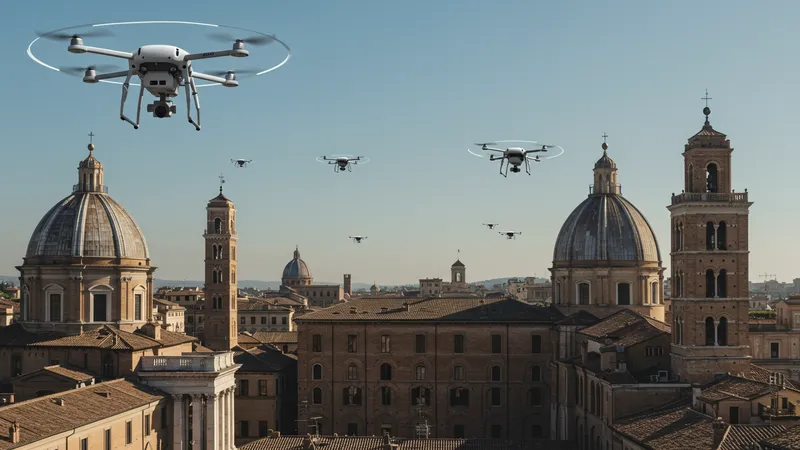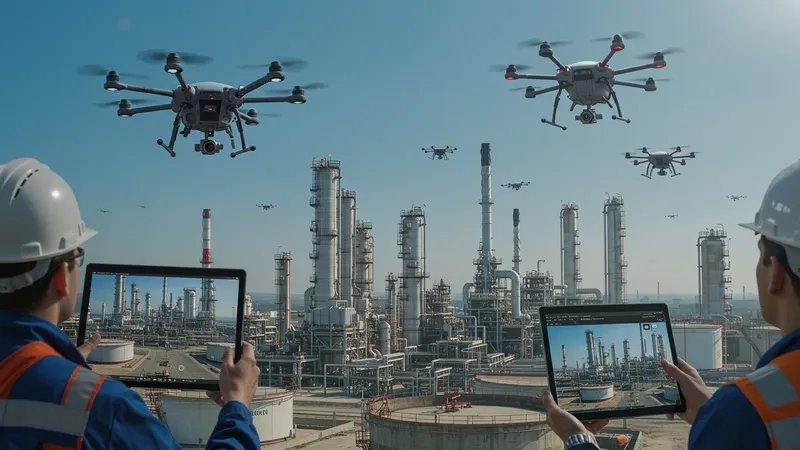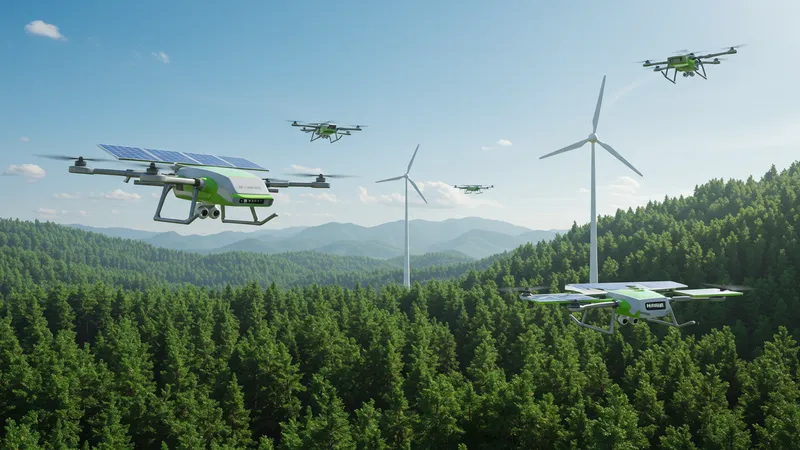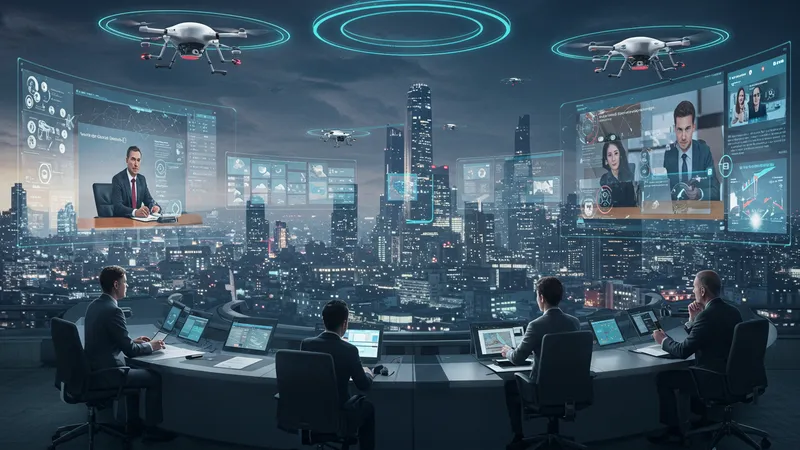

Imagine a world where the sky is the limit for infrastructure management, literally. Drone inspection photography is revolutionizing the way Italy maintains its breathtaking architecture. But here’s the catch: it's happening right under our noses!
As technology surges forward, the demand for efficient, cost-effective infrastructure management is at an all-time high. Drones swooping through cities capturing data effortlessly are not science fiction—they’re today’s reality. Could this start a new era in Italian engineering?

Historically, infrastructure inspections in Italy meant long hours, high costs, and safety risks. Enter drones: these high-tech flyers are slashing inspection times by up to 75%. Builders and engineers now buzz with excitement—and caution. Italy’s ancient bridges now meet the future as drones detect weaknesses invisible to the human eye. But that’s not even the wildest part…
Drone technology is not only streamlining management but also revealing unexpected gems. The Colosseum's arches, for example, showed deterioration patterns previously hidden. These flying sentinels are ushering experts into a new era of preventative measures, saving millions. But the real surprise?
What happens next shocked even the experts…
From above, Italy's infrastructure tells a story previously unheard. Drones offer new angles and perspectives that architects could hardly imagine before. The result? Aerial data that reveals inconsistencies in structures, adding precision to maintenance routines. Imagine controlling the time machine for Italy’s historical sites—these insights are invaluable. But there’s one more twist…

Insider tips reveal that drones are not just for observation. Certain models now include infrared scanning, uncovering heat leaks from buildings that could compromise energy efficiency. Italy's green movement stands to gain as drone technology helps meet eco-targets efficiently. What you read next might change how you see this forever.
The drones don’t merely orbit the Colosseum, they are revolutionizing how architects draft restoration plans. Detailed 3D models derived from drone data afford precision beyond what static ground-based techniques ever could. Consequently, Italy’s infrastructure stands poised on the precipice of a transformation that will ripple across centuries.
Here’s the kicker: as local governments embrace this innovation, drone photography paves a bright path. The amalgamation of old with new holds lessons that extend beyond any paper blueprint. But what does this mean for the future of infrastructure?
Ancient Roman aqueducts once carried life-giving water into cities, and now drones help preserve these marvels. Equipped with lidar technology, drones penetrate dense foliage and detect structural flaws invisible to regular scouts. It's detective work on a monumental scale, armed with pixels and precision.

You'll be amazed to learn that these flying sleuths can ascertain the rate of deterioration of monuments like the Leaning Tower of Pisa with startling accuracy. The implications for historical preservation are profound, warning of potential collapses decades in advance. But there’s still more to unearth…
In shedding light on aging structures, drone imaging is also unearthing lost circuits of forgotten Roman roads. These rediscoveries enrich Italy's rich tapestry, connecting the dots between ancient pathways. The ripple effect on tourism and education is merely starting to unfold, with national museums racing to integrate newfound treasures into tours. What could be next on the list of rediscovered gems?
With newfound clarity on old structures, engineering firms are rehearsing for the unexpected: earthquakes, floods, and urban expansion. And yet, the real drama unfolds in the legal realm, where the use of drones is creating new rules for the skies. What legal hurdles loom, and how will they shift focus from ground to clouds?
As you delve into drone technology, a web of regulation awaits. Italy, with its rich historical backdrop, has stringent aviation rules governing UAVs (Unmanned Aerial Vehicles). The balancing act is delicate, given the blend of urban buzz and national heritage. This is about more than just following the rules; it’s pioneering a new aerial etiquette.

Drone pilots in Italy must undertake meticulous certification processes to ensure safety and compliance. Experts suggest that a simplified framework could propel wider adoption of drones across various sectors. But just when you think the skies have cleared, new complexities emerge…
The symphony of technology and tradition makes Italy a unique theater of challenges and breakthroughs. Privacy concerns, for instance, have become a key battleground, with new legislation focusing on data security and citizen privacy. The conversation doesn’t stop here; it’s reshaping international conventions on aerial privacy. What about the surveillance potential—where do drones draw the line?
As with any technological leap, innovation persists in the face of skepticism. The key question arises: will Italy’s intricate drone legislation align with the burgeoning needs of infrastructure management? Each legislative maneuver is a strategic move on the chessboard of technological adoption. So, what's next in this regulatory saga?
The headline captures the allure—drones are cutting costs dramatically. From €200,000 for a traditional inspection to just €20,000 with drone aid, the savings are setting precedents. But the figures only tell part of the story; what about long-term economic stability?

By minimizing human error and operational hazards, drones offer a safe, scalable solution. The broader implication is not just about money—it's about rethinking allocations in urban planning. A penny saved here channels funds into innovation elsewhere. The fiscal domino effect is breathtaking. Could this be the catalyst for a broader economic shake-up?
While the technology rolls out across the country, SMEs (Small and Medium-sized Enterprises) stand to gain mightily by bypassing traditional barriers. Precision not only prevents catastrophes but also nurtures a culture of anticipation. So, as Italy embraces drone technology, what realms of opportunity open up next?
Drone deployments spark an evolution rather than a revolution—an evolution aligning modern efficiency with historical preservation. The magnetism in combining the past with future insight transforms infrastructure management beyond recognition. And yet, questions linger about sustainability. What might the next chapter of drone technology reveal about eco-conscious practices?
Drones have a lesser-known side: they're eco-warriors in disguise. These high-tech devices consume minimal power compared to traditional machinery, inherently supporting Italy's push toward a greener future. But can they do more?

Eco-innovators in the drone industry are striving for sustainability, incorporating solar charging panels and eco-friendly materials. Drones could soon contribute to carbon offset policies rather than exert additional strain on our ecosystem. Pioneering green drones is not only a goal but also an ideal necessary for planetary wellness.
In a country where sustainability is becoming a pivotal criterion for acceptance, every flight becomes part of a greater narrative. These technological ambassadors demonstrate a commitment to a circular economy. However, there's a question that runs deeper—you'll want to know what unexpected hurdles lie in developing these green marvels.
As the narrative of drone-assisted infrastructure unfolds, it ventures beyond logistics and enters a philosophy about nature and innovation intersecting. The picture paints a future of sustainable synergy, but pinch yourself—this is no dream! It’s the inevitable chapter in Italy’s infrastructural evolution.
Drone technology not only bridges rivers but also bridges the gap in public knowledge. Providing access to real-time data to local communities fosters transparency and engagement. Imagine neighborhoods with the power to peek at infrastructure health in their own backyards.

This participatory paradigm creates educational outlets, inviting curious minds and bright futures. Community forums around Italy are growing increasingly curious about the drone revolution taking flight above them. Decoding these digital narratives adds depth to civic pride. But the mystery grows: what widespread influence could grassroots drone knowledge wield?
Public workshops are springing up, teaching citizens about drone operation and data interpretation. It’s a wave of empowerment, lending a voice to community-driven planning. The missing piece in community engagement is redefining digital literacy—an insight key to understanding the broader technological landscape.
The impact isn't limited to civic duties but spirals into educational curricula too. Universities are scurrying to sculpt programs and spotlight drone tech in engineering syllabuses. Instruction now transcends the technical—it’s adapting to meet the cognitive and ethical demands of a drone-fueled era. Can this momentum infiltrate the classical educational strongholds and redefine academic pursuits?
While much of the focus remains on utility and efficiency, let's not forget the artistry drones can inspire. Italian photographers and artists are harnessing this technology to capture ethereal vistas that redefine what we've known as travel photography.

These creative applications foster an unscripted renaissance in digital art creation. But the real beauty lies in blending tradition with innovation, where artisans infuse modern techniques with age-old crafts. It's an evolution in the aesthetics lens—a celebration of culture from an aerial perspective.
From capturing traditional Sicilian festivals to documenting serene Tuscan sunsets, drones offer unparalleled access to the soul of Italy. Their high vantage doesn't only change the view; it transforms narratives in a way never before accessible. Will these artistic flips crisscross into motion pictures and further dynamic media?
Artists are contemplating their next moves, integrating drone footage as a pivotal component in exhibits. The fascination with drones stitches lineage with contemporary flair, forming an unexpected ally in Italy’s craft preservation. As drones pan the landscapes, we're reminded of one enthralling truth: the view from above illumines daily life with the divine.
Safety isn’t left in the dust of progress. Italy’s infrastructure managers are pioneering aerial inspections with drones to enforce rigorous safety protocols. The succinct message is one of proficiency—avoiding calamity by discovering vulnerabilities before catastrophe strikes.

Drones’ hands-off approach minimizes human risk, removing personnel from dangerous inspection scenes. These skyward scouts retain high-definition surveillance capabilities, patrolling from the Etruscan ruins to bustling modern highways. Even construction sites are honing drone techniques to uphold safety standards. Yet beyond safeguarding, what ethical dilemmas surface?
Interwoven with the surveillance come issues of consent and oversight. Italy’s progressive standard demands respect for individual rights within these security enhancements. The debate on holding power within boundaries gains intrigue as drone schemes push legal frameworks forward, balancing surveillance with autonomy.
Decoding the ethical code challenges institutions to rethink old frameworks, and encouragingly, drones blur discipline lines, fusing areas of safety, privacy, and policy. Translating these insights into actionable measures becomes tantamount. As public trust solidifies, improvements reinstate techno-ethics and support narrative rewrites from cautious acceptance to forthright cooperation.
The renaissance imagery doesn't cease with artistic expressions—for Italy, it means tangible infrastructure revivals. Implementing drones into urban renewal initiates brief interruptions to dust off the layers of history intertwined with modern advancements.

These drones offer x-ray-like insights into the minutiae of infrastructures, diagnosing with surgical precision. The payoff transcends mere maintenance: housing, roads, and commercial zones experience upturns, breathing new vivacies into beloved spaces. The next stanza poses, can drones rejuvenate even industries teetering on paths less worn?
A new chapter emerges, where industries like tourism fuel curiosity and grow alongside revitalization tales. Italy’s timeless allure sings new songs to the millions floating through surfaces interlaced with technicolor inspirations. Amid thriving sectors, Italy's landscape transforms into living exhibitions—travelers experience synergy in authentic, rejuvenated settings.
Reenvisioning Italy's infrastructure ensnares the classical with contemporary vigor. It builds a narrative of continuity and evolution, elevating both historical homage and forthcoming innovations. The larger impression reveals: this is not the end—merely a script in flux, propelled by drones carving along Italy’s perpetual contours. But, will Italy's distinct tapestry sustain these transformations for generations yet to unfold?
As drone usage flourishes, the dialogue around governance continually shapes evolution. Collaborations echo from local domains to state frameworks, crafting policies responsive to rapid growth. Eyeing challenges, Italy’s governing bodies lean toward dynamic policy shifts that feed into technological intersectionality.

Democratically shaping the skies harmonizes public conscience with directives, thus innovating at grassroots levels. Public consults infuse transparency within decision-making processes, underscoring the importance of government-society dialogues around drone potential. But what's the complexity in navigating this emerging dialogue while keeping pace with advances?
Drone policy intricacies gradually blend into constitutional conversations, reconciling preservation and automotive growth. Setting precedents often transforms into enigmatic puzzles, where stakeholders adjust lenses to gain holistic insights. The unknown remains: how will these regulatory symphonies orchestrate finality before, and beyond, future tipping points?
Trust-building, core to governance ethos, seeds alliances beyond simple legislation. Italy perpetuates cycles of reform, responsive to technologically cultured climates. As drone dialogues evolve, they pave responsible paths conducive to economic vigor. Yet, the enduring question teases our intrigue: what outcomes will harmonized policies yield in this ethereal orchestration of governance and technology?
As Italy navigates the captivating realm of drone-assisted infrastructure management, each innovation symbolizes a step toward a combined legacy of history and modernity. The impact is far-reaching—a bold testament of marrying visionary technology with Italy’s age-old traditions. These flying marvels offer more than stunning vistas; they map a journey that challenges, engages, and ultimately reshapes the cultural fabric.
Share these revelations, mark this voyage of discovery, or dive into this evolving dialogue—you'll witness Italy’s infrastructural metamorphosis not just as an observer but an integral part of a transformative story. With each soaring flight, Italy’s skies promise thrilling narratives yet to soar into our collective consciousness.